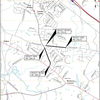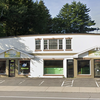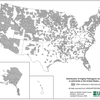After witnessing car accidents for years, Berne residents on Helderberg Trail wonder what can be done
BERNE — As they looked at the gray SUV that stuck nose-up out of the pond at their 381 Helderberg Trail (Route 443) property in Berne last month, Melanie and Gunner laCour had trouble figuring out where it came from because there were no tire marks in the snow to give any suggestion.
“This lady apparently lost control of her vehicle way up on top of the hill, was going so fast by the time she got to the bottom, missed the guardrail [between the pond and the road], and went airborne over our pond and landed on the other side of it,” Gunner laCour told The Enterprise this week.
It’s the fourth accident the laCours have seen on that curvy stretch of road — including one that killed their dog — since they bought their house four years ago from Gunner laCour’s aunt and uncle, who themselves have “innumerable stories” of car wrecks, Melanie laCour said.
“The issue that we see is that we have a turn that starts in front of our house and continues by [our neighbor’s] house,” Melanie laCour said. “People head into that turn going towards Berne at speeds that are just too fast, because there’s not a lot of signage about how sharp that turn is.”
LaCour said that the speed limit is 55 miles per hour, but her husband said that they’re “lucky” if people only go that fast.
“Even big trucks,” Gunner laCour said. “We can hear them slamming on their jake brakes trying to make this turn.” A jake break is an engine brake for truck diesel engines that cuts off fuel flow.
When he’s out in the field on his tractor, laCour said he observes speeders pass slower cars “over and over and over,” hardly minding the oncoming traffic.
“To go to the field across the road, I’ve almost been run into so many times I can’t even count,” he said. “I mean, I’ll get hurt, but they’re the ones that are going to get killed.”
The laCour’s neighbor, George Duell, told The Enterprise that he was complaining about traffic speeds in that area for decades before the New York State Department of Transportation put signs with cautionary arrows up to warn drivers about the upcoming angle.
One month after the signs were put up, Duell said, his adult son was pulling out of Duell’s driveway with his own son and another young relative when a driver nearly took them out.
Another time, a teenager in a pickup truck going at least 30 miles over the speed limit was just barely saved when his truck burst into flames and Duell’s son yanked him out, only for the driver to ask Duell’s son to go back and get his cigarettes, Duell said.
The Enterprise covered an accident in that same spot more than two years ago, which had involved a truck towing an 8,000-pound boat that came loose and was totaled, spraying Duell, who was nearby, with gravel and glass.
After that accident, Duell said this week, he installed 27 concrete blocks to reinforce the guardrails he had built of utility poles so that errant vehicles don’t come launching onto him, his family, or his home.
He also won’t let his grandson get off at the school bus stop nearby because of the hazard involved. Instead, his grandson gets off on nearby Stage Road and crosses through a backyard and over a bridge that Duell had built for him.
“I did as much as I can possibly do here,” Duell said. “But I still almost lost my son and my grandson and my cousin’s little girl out here on the end of the driveway.”
Both Duell and the laCours say that the only solution they can think of is to reduce the speed limit to 45 miles per hour, since other options, like greater enforcement by the Albany County Sheriff’s Office have failed.
“We’ve talked to the sheriff about it and they’ve sent some deputies out to sit around … but they can’t stay here forever,” Gunner laCour said. “And as soon as people notice, they slow down until [the deputies] leave.”
The state’s Department of Transportation disagrees that the speed limit should be lowered, though, as the department stated to former Berne Town Board member Joel Willsey, who used to work for the department and has been a vocal advocate of road safety in recent years.
Willsey had requested crash analyses and speed-limit reductions at various points along Route 443 last year in his capacity as board member, and the Department of Transportation responded that accident histories in each case were unremarkable and that lower speed limits were unjustified.
“Generally, lowering the speed limit does not necessarily reduce the operating speed,” Department of Transportation Regional Traffic Engineer Mark Pyksadlo wrote in a letter responding to Willsie’s requests. “While some drivers will blindly obey the new speed limit and any posted regulatory sign, most drivers will drive at a speed that they feel safe and comfortable at, which is usually near the 85th percentile speed.
“The result is that when a speed limit is unjustly lowered, there is significant deviation in operating speeds,” the letter continues. “This is reflected in what we call the ‘pace.’ Safety (crash reduction) is improved when the 10 MPH pace speed is closer to the 85th percentile speed. A wide distribution of operating speeds can lead to aggressive driving, road rage, rear end collisions, improper passing maneuvers and a less safe condition despite lowering the speed limit.”
The wiser alternative, the letter states, is for a local municipality to obtain a work permit from the department to obtain a sign that displays drivers’ detected speeds, and provides the name of Department of Transportation employee Reed Sholtes along with his number — 518-457-5283 — for follow-up.
The Department of Transportation could not be reached by The Enterprise for this story, nor could the Albany County Sheriff’s Office.



